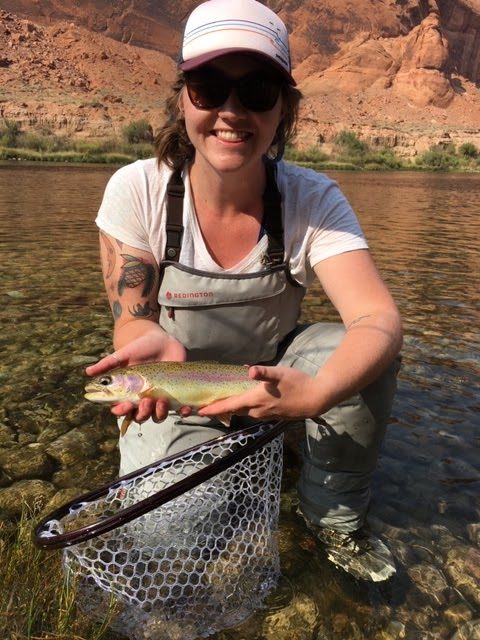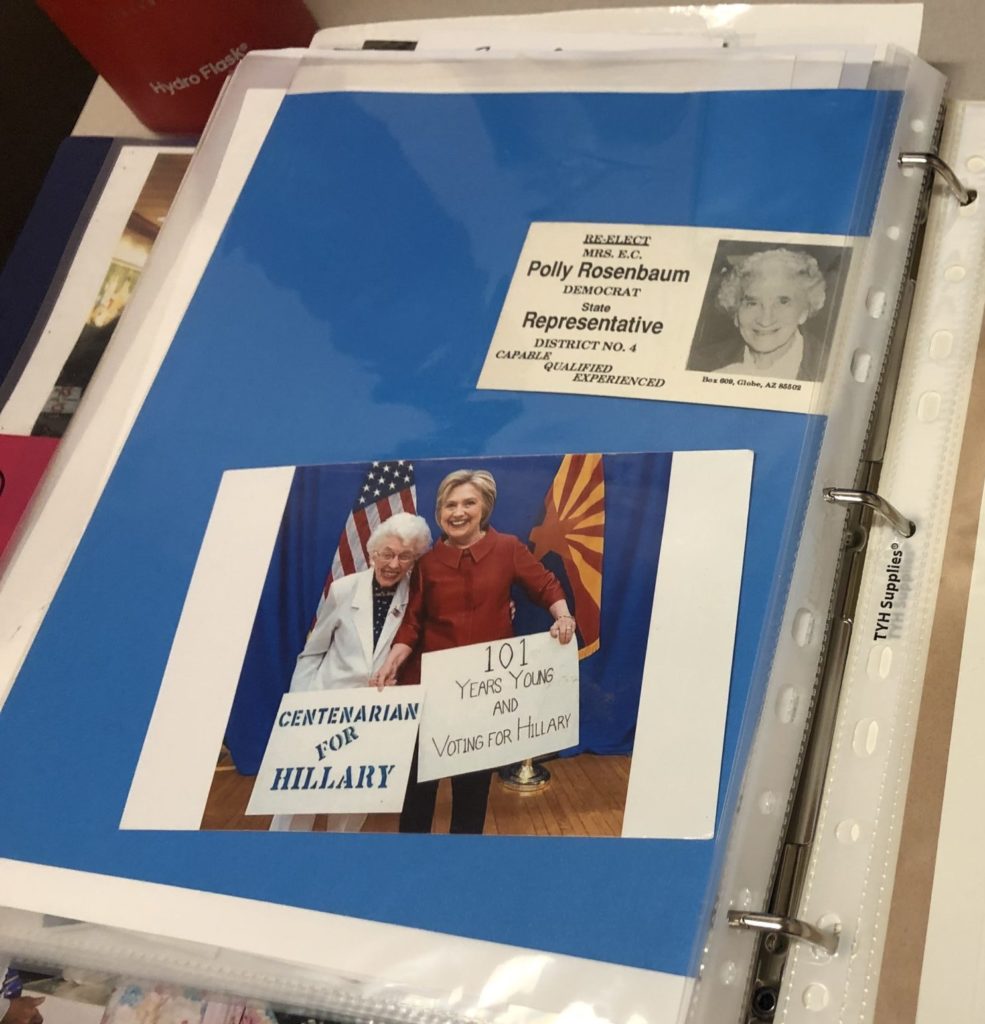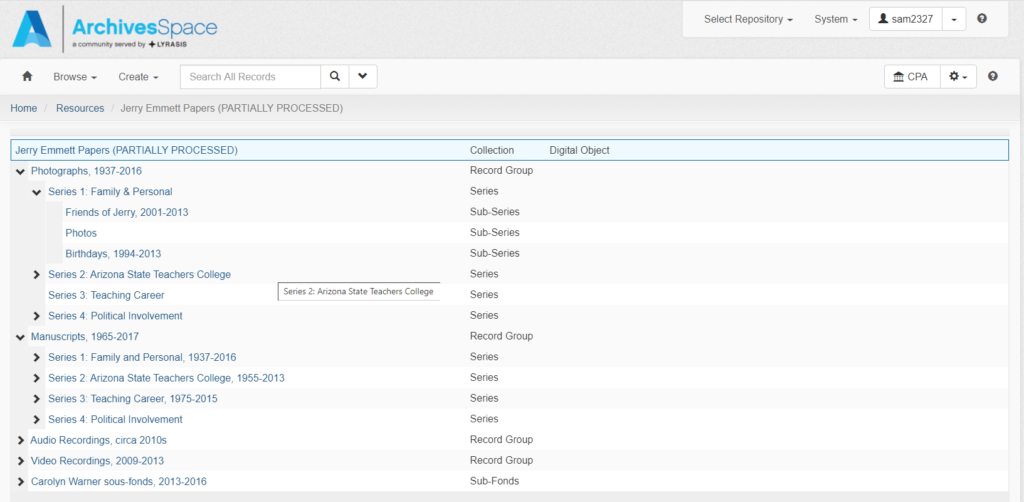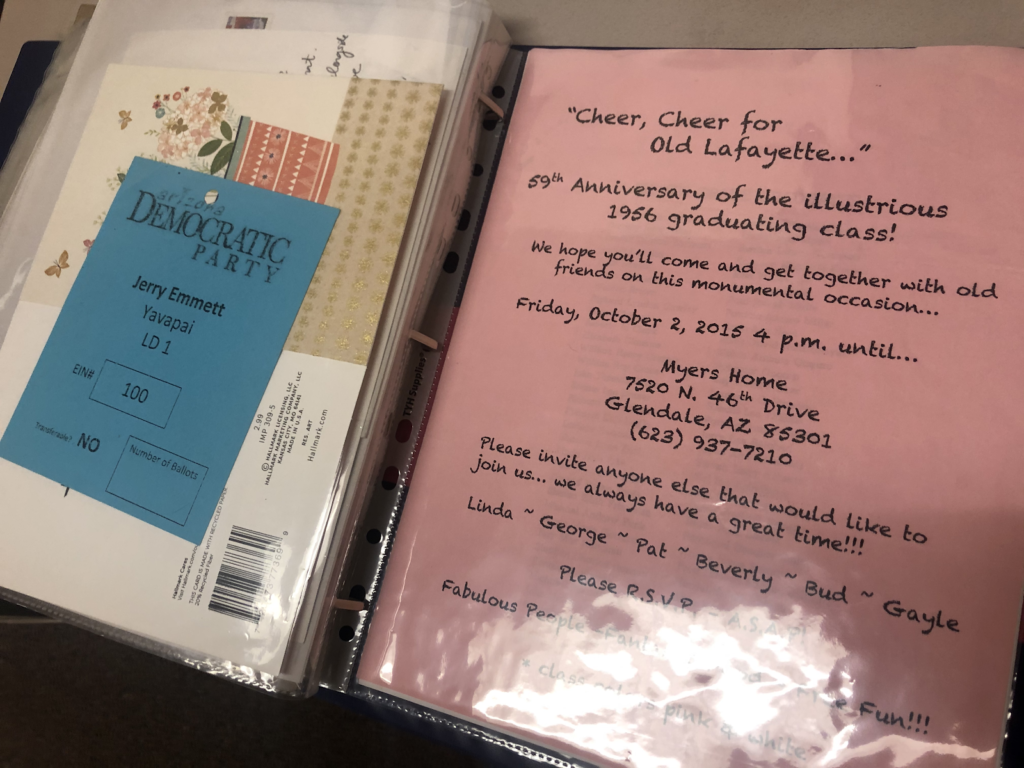Geraldine “Jerry” Emmett is likely one of the most infamous centenarians in Arizona’s history. A two-time graduate of Northern Arizona University (NAU), she was born two years after Arizona achieved statehood and five years before American women’s right to vote was enshrined in the U.S. Constitution, historical events which would profoundly shape the course of her life. In 2017, her family donated personal scrapbooks, binders, photographs, and other materials to Cline Library’s Special Collections & Archives in order to preserve a documentary record of Jerry Emmett’s extraordinary life. These are now titled the “Jerry Emmett Papers.”
But before we jump into Jerry Emmett’s story, a bit of background…
About the intern
My name is Megan Connolly. In addition to my role as Executive Assistant for the Office of Alumni Engagement at NAU, I am currently a student at the University of Arizona, working on my Master’s Degree in Library and Information Science (MLIS). As part of my coursework, I needed an internship where I would get hands-on experience working in a library—or in my case, an archive.

Cline Library’s Special Collections & Archives (SCA) offered to host me as an intern, assigning me primary responsibility for processing the Jerry Emmett papers under the supervision of Sam(antha) Meier, Archivist for Discovery. My internship was intended to be a start-to-finish project touching on all aspects of archival appraisal, arrangement, and description, culminating with the digitization of selected material from the Jerry Emmett papers.
While my work began without any issues, quickly my internship had to move online due to the COVID-19 pandemic, and I could no longer handle Jerry Emmett’s materials in person. I was disappointed not to be able to continue my work at Cline Library, but I was equally determined not to let the coronavirus impede the progress I had made.
Now, onto the Jerry Emmett papers!
About Jerry
As I learned from reading the two self-published autobiographies included in the Jerry Emmett papers, Geraldine (Jerry) Emmett was born in 1914, before the 19th Amendment was passed. The political importance of women’s suffrage influenced her life greatly. She became involved in Arizona politics in her youth, when she played ukulele and sang at Arizona Governor George W.P. Hunt’s reelection campaign in the 1920s.
Emmett pursued her education at what was then Arizona State Teachers College at Flagstaff, graduating with a Bachelor’s Degree in Education in 1937. After receiving her degree, she began teaching in Kayenta, Arizona, on the Navajo Nation. Jerry Emmett taught throughout Arizona for 40 years, spending the majority of her career at Lafayette Elementary School in Phoenix, Arizona (now Larry C. Kennedy School).
Throughout her career, Emmett stayed active in politics and the Democratic Party at the state and the national level. She was neighbors-turned lifelong-friends with Carolyn Warner, former Arizona Superintendent of Public Instruction, gubernatorial candidate for Arizona, and U.S. Senate candidate. With Warner at her side, Jerry Emmett attended many Democratic National Conventions, meeting the likes of Hillary Rodham Clinton, Barack Obama, Al Gore, and more.

In 2016, Emmett served as an honorary delegate from Arizona for presidential nominee Hillary Clinton at the Democratic National Convention in Philadelphia, Pennsylvania. She was 102 years old. Many of the clippings in Emmett’s papers pertain to her role as delegate.
Jerry Emmett passed away on April 30, 2019, at the age of 104.
Starting the process
Processing the Jerry Emmett papers was supposed to be fairly straightforward. I would create an inventory to reflect the “found order” of the materials before moving on to drafting a finding aid and carrying out physical processing tasks such as rehousing materials into appropriate storage like archival folders, Mylar sleeves, and so on for their long-term preservation and care.
Emmett’s papers had lots of different facets, format-wise. When I started working on them, they included a photo album, three pink 3-ring binders filled with mixed media, audio recordings on microcassettes and audio cassettes, video recordings on mini DVD-Rs, two self-published autobiographies, and a scrapbook. Before I even started my internship, SCA received a small accrual of materials about Jerry Emmett created by Carolyn Warner, including 390 digital photos from Jerry Emmett’s 100th birthday party on a CD! With so many different formats to work with, I knew different aspects of the papers would have different needs.
Initially, I used ArchivesSpace to create an inventory of the items to see what was actually in the Jerry Emmett papers. Recording information about everything that was there and how it was presented helped me document any “original order” in evidence at the time that SCA received these materials. I also took photographs of the materials as they were when I began my internship to help guide my processing decisions later on.
Based on my inventory, I created a collection-level finding aid which included biographical information about Jerry Emmett and a broad overview of what was in the Jerry Emmett papers. I used oXygen XML editor to edit the finding aid so that it could be ingested into Arizona Archives Online. This collection-level guide let folks who are browsing SCA’s collections know that the Jerry Emmett papers exist, but that they are not processed in any way, and so if anyone would like to view them, they could request further help from SCA staff to access the materials.
Preserving Jerry’s mixed media memories
Due to the way that Emmett’s materials were originally put together, there were — and at this moment, still are—some preservation concerns. The binders with mixed media needed to be taken apart in order to be preserved for future use, but this is pretty delicate work.
After consulting with SCA staff, I decided to physically take the binders apart, putting photographs with other photographs, newspaper clippings with other clippings, and generally grouping like materials with like.
We reached this decision for two reasons, the first being ease of access. With so many of Emmett’s photographs of one event, like a Democratic National Convention, spread out over three different binders, it made sense to place all of the photographs from that event in one place. Same thing with Emmett’s correspondence and clippings. I believed it would be much easier for a researcher to locate relevant textual materials when they’ were organized chronologically or by content, which was how I proposed arranging the collection.
Secondly, we concluded that keeping similar formats together would allow SCA to store different types of materials in appropriate environments and similar housing, which would be best for long-term preservation.
Putting Jerry’s memories online—from home
It was during the time that I was physically sorting the materials according the format in order to fully process the collection, as well as working with the Digital Programs Archivist, Kelly Phillips, to digitize Emmett’s microcassettes that I was asked to switch to a remote-only internship. We had one day of warning, which allowed me to take photos of everything I had been working on so that I could consult them from home. From there, I was able to accomplish other various tasks associated with the project remotely, with the help of SCA staff.
For Jerry Emmett’s born-digital materials, notably the CD from her 100th birthday party mentioned above, I looked through all the photographs, chose about 20 that I thought represented the whole well, and created descriptive metadata for those items so that access copies of those images could be added to Digital Collections. My selections can be found here.
Special thanks to digital programs staff Kelly Phillips and Jess Vogelsang for working on getting the access copies (also known as “DIPs,” or “dissemination information packages”) and their associated item numbers to me, so that I could finish that!
While I also reviewed video recordings on mini DVD-Rs, I was unable to finish appraising their content and working with digital programs staff to transfer their contents due to the pandemic. I did, however, work with Kelly Phillips to digitize and review Emmett’s audio recordings on microcassette! Those are now available through Digital Collections here.
Since my internship finished remotely, I was unable to physically process much of the materials for long-term preservation. The Jerry Emmett papers were left in a state where I had taken apart the binders and began to group things by format, but had not yet finished housing or describing them. Instead, I created a number of reports which laid out my thinking on how these partially-processed materials should be fully processed and then arranged for preservation and access. This will allow the next person who works with the Jerry Emmett papers to understand my thinking, see where I left off, and complete the processing as I would have liked it to be done.
Wrapping up, remotely
Once I had a much clearer picture of the Jerry Emmett papers as a whole, I was able to create two more finding aids, one of which reflects how the materials are currently organized, and the other which lays out my proposed final arrangement.
The former finding aid is available through Arizona Archives Online here, so that researchers can find and (hopefully) access the Jerry Emmett papers even though I was not able to finish processing them.

The latter finding aid, shown above, allows SCA staff to see how the papers could be arranged in a more organized state, and it will be implemented once SCA staff are able to return to Cline Library and pick up where I left off. It is currently hosted in ArchivesSpace, accessible only to Sam and other SCA staff who may use it in the future.
While my internship was not a start-to-finish project, as anticipated at the beginning of the semester, it was still valuable work for me to do and to learn from. Ultimately, I am just grateful to SCA for not only allowing me to begin archiving the Jerry Emmett Papers, but to finish as much as I could in such a weird time. I’ve learned through both hands-on and remote work many new things. My experience in Special Collections and Archives has been wonderful, both in person and from afar.
To learn more about the Jerry Emmett papers, please review the Jerry Emmett Papers finding aid available through Arizona Archives Online or digital material from the Jerry Emmett papers available through Digital Collections. Interested researchers may contact Sam Meier, Archivist for Discovery, with further questions.


